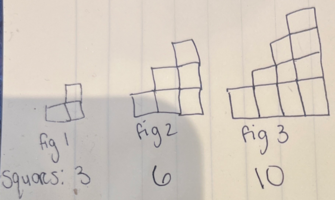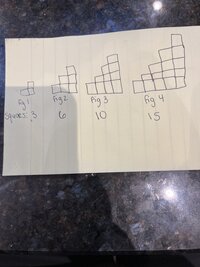You are using an out of date browser. It may not display this or other websites correctly.
You should upgrade or use an alternative browser.
You should upgrade or use an alternative browser.
Developing Algebraic Equations (number of squares in "staircase")
- Thread starter Eew3456
- Start date
Otis
Elite Member
- Joined
- Apr 22, 2015
- Messages
- 4,592
Hi. If we count squares by adding row totals, does that give you an idea? (For completeness, I'll include an extra figure that has only one square.)what algebraic equation represents the total number of squares for the figures
1 = 1
1 + 2 = 3
1 + 2 + 3 = 6
1 + 2 + 3 + 4 = 10
1 + 2 + 3 + 4 + 5 = 15
Have you seen sigma notation or any summation formulas – listed under 'Useful Shortcuts' here? (There are various ways to not count that extra square above.)
If not, then please tell us what your class is currently studying.
[imath]\;[/imath]
Dr.Peterson
Elite Member
- Joined
- Nov 12, 2017
- Messages
- 16,619
What is the "typical staircase problem", as you understand it? Maybe we can modify its answer to fit this. (Algebra is good at doing that.) Or maybe we can modify its method of solution.View attachment 35096
Trying to figure out what algebraic equation represents the total number of squares for the figures. I figured out that the height equation is n+1. The total number of squares isn’t the same as the typical staircase problem since figure one is the 3 squares.
- Joined
- Nov 24, 2012
- Messages
- 3,021
The nth triangular number is:
\(\displaystyle T_n=\sum_{k=1}^{n}(k)\)
Perhaps the simplest way to find this closed form is to write:
\(\displaystyle T_n=1+2+3+\dots+(n-2)+(n-1)+n\)
\(\displaystyle T_n=n+(n-1)+(n-2)\dots+3+2+1\)
Adding, we find we have n summands of n + 1:
\(\displaystyle 2T_n=n(n+1)\)
Thus:
\(\displaystyle T_n=\frac{n(n+1)}{2}\)
\(\displaystyle T_n=\sum_{k=1}^{n}(k)\)
Perhaps the simplest way to find this closed form is to write:
\(\displaystyle T_n=1+2+3+\dots+(n-2)+(n-1)+n\)
\(\displaystyle T_n=n+(n-1)+(n-2)\dots+3+2+1\)
Adding, we find we have n summands of n + 1:
\(\displaystyle 2T_n=n(n+1)\)
Thus:
\(\displaystyle T_n=\frac{n(n+1)}{2}\)
Dr.Peterson
Elite Member
- Joined
- Nov 12, 2017
- Messages
- 16,619
If I assume that the "staircase problem" you mention is the triangular numbers, as @MarkFL has presented it, you seem to be troubled only by the fact that this problem starts with 2 layers for n=1:View attachment 35096
Trying to figure out what algebraic equation represents the total number of squares for the figures. I figured out that the height equation is n+1. The total number of squares isn’t the same as the typical staircase problem since figure one is the 3 squares.

(That assumes your n is the number of the figure.)
If so, then your F(n) is just Tn+1. For example, F(1) = T2 = 2(2+1)/2 = 3.
What formula does that give you, if you replace n with n+1?
This looks like a finite math kind of question. I would look at the height.
n = 1 -> blocks = 1
n = 2 -> blocks = 3
n = 3 -> blocks = 6
n = 4 -> blocks = 10
So if you sum up the n numbers, you get the total blocks.
The general formula to find the number of blocks is n!
So for example if the height is 4 then n=4, and n! = (4+3+2+1) = 10
n = 1 -> blocks = 1
n = 2 -> blocks = 3
n = 3 -> blocks = 6
n = 4 -> blocks = 10
So if you sum up the n numbers, you get the total blocks.
The general formula to find the number of blocks is n!
So for example if the height is 4 then n=4, and n! = (4+3+2+1) = 10
Oh yeah, it is the E symbol, but I don't know how to put that inThe factorial is a product, not a sum.
\(\displaystyle n!=\prod_{k=1}^{n}(k)\)
blamocur
Elite Member
- Joined
- Oct 30, 2021
- Messages
- 3,104
\sum : [imath]\sum[/imath] ? I believe the Greeks call it "sigma" ([imath]\Sigma[/imath])Oh yeah, it is the E symbol, but I don't know how to put that in

